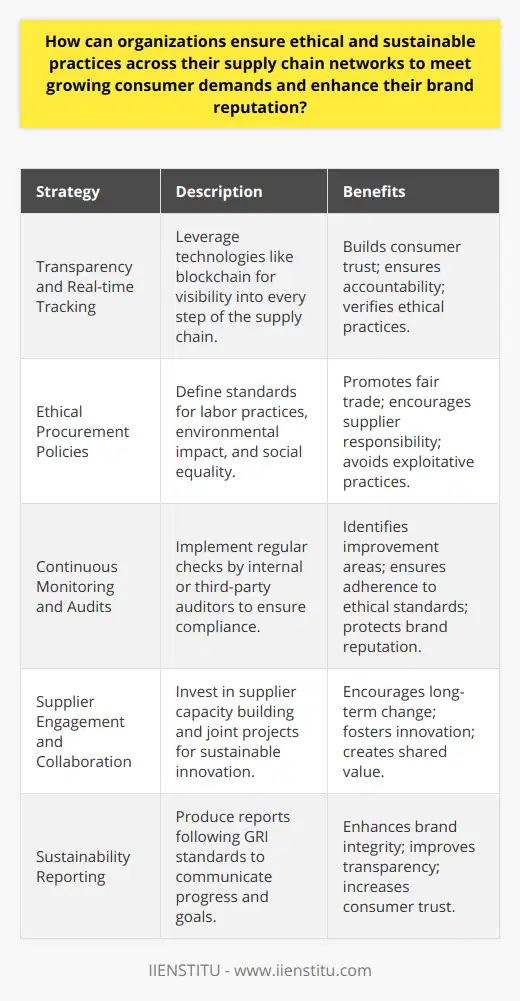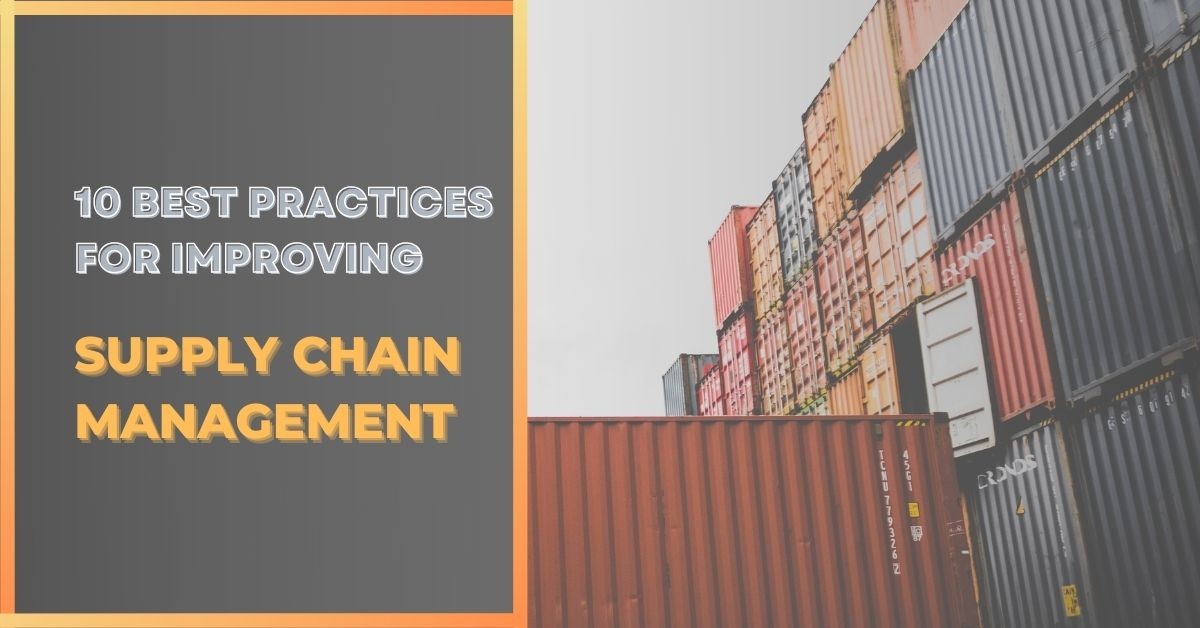
Consider implementing a supply chain management system to make your business run smoother. The basics of this are to keep track of inventory and orders and shipping time which can save you both money in the long run!
If you're looking for ways to make your business run smoother, you should consider implementing a supply chain management system. It can help you keep track of your inventory, orders, and shipping, saving you time and money. This blog post will discuss the basics of supply chain management and how it can benefit your business.
How To Make Your Business Run Smoother?
Supply chain management is the backbone of any business. If it's not working, you'll never be able to turn a profit, and that would break our hearts into pieces! But don't worry - there are some easy steps we can take so your supply chains stay running smoothly:
1) Make sure you have a good relationship with your suppliers
If you have a good relationship with your suppliers, they will be more likely to work with you and help you when there are problems. They will also be more likely to give you preferential pricing and discounts.
2) Plan
If you plan, you will be able to avoid any problems that might occur further down the line. This will also help you budget better and ensure you have enough stock to meet demand.
3) Communicate with your suppliers
Make sure you communicate with your suppliers regularly. This will help ensure that everyone is on the same page and that there are no misunderstandings. It will also help to prevent any problems from occurring.
Cutting-edge Supply Chain Optimization Strategies For Maximum Efficiency And Performance
Ethical Dilemmas İn Supply Chain Management İnterview Questions
4) Use technology to help you manage your supply chain
Technology can be an excellent tool for managing your supply chain. There are several different software programs available that can help you keep track of everything. This will help ensure that everything runs smoothly and that you can respond quickly to any problems that may occur.
5) Train your staff
Make sure you train your staff to use the technology and software that you have in place. This will ensure that they can use it effectively and that they know how to respond to any problems that may occur.
6) Keep track of your inventory
It’s essential to keep track of your inventory and ensure you have the correct stock levels. This will help ensure that you can meet demand and that you don’t run out of stock.
7) Be prepared for disruptions
Disruptions can happen at any time, and it’s essential to be prepared for them. Have a plan in place for how you will respond to disruptions and make sure your suppliers are aware of them. This will help to ensure that there is minimal disruption to your business.
8) Regularly review your supply chain
It’s essential to regularly review your supply chain and ensure it is still the best option for your business. This will help you to ensure that you are getting the most out of it and that it is still meeting your needs.
Supply chain management can help your business run smoother, make better decisions, and save money. If you are not currently using it, I highly recommend considering it. It can be an excellent tool for improving your business.
What Are The Different Aspects Of Supply Chain Management?
The importance of supply chain management and how it can be used to improve your company's bottom line should not be underestimated. Many aspects go into this topic, with some being more vital than others depending on what you need from them at any given time - these vary from getting new products made or receiving shipping information in order, for example.
Supply chain management is a vast and complex topic, with different aspects often overlooked in favor of more lucrative initiatives. However, without these vital tasks, it would not be possible to produce or deliver goods on time with high-quality standards, which can directly lead to lost revenue!
Here's an overview of the different aspects of supply chain management and what each one entails:
Planning and forecasting: This is the process of predicting future demand for goods and services to ensure that resources are available when needed. It includes analyzing past sales data, as well as trends, to make accurate predictions.
Purchasing: The purchasing department is responsible for acquiring the necessary materials and goods to meet production demand. This includes negotiating prices, verifying the quality, and ensuring deliveries arrive on time.
Production: Once the necessary materials have been acquired, it's then up to the production department to turn them into finished products. This process includes organizing and scheduling workers and overseeing the manufacturing process.
Distribution and delivery: Once products are finished, the distribution and delivery department's job is to get them to the customer. This includes organizing transportation, managing inventory, and dealing with customer inquiries or complaints.
By understanding the different aspects of supply chain management, businesses can ensure that their operations are running as smoothly as possible. In addition, by streamlining these processes, it's possible to improve efficiency, reduce costs, and increase profits.
Measuring performance is an essential part of supply chain management. Tracking production, delivery times, and inventory levels can identify any potential issues before they become more significant problems. Periodically reviewing your data will help you stay on top of things and make necessary adjustments. If you want to learn more about effectively measuring performance and managing your supply chain, join our online supply chain management course today.
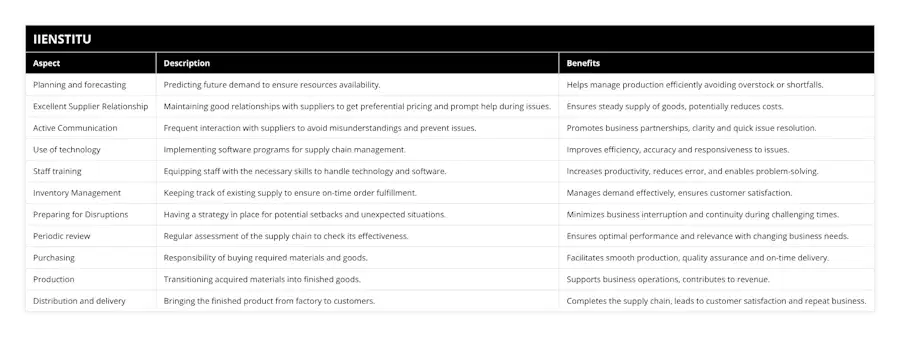
The implementation of a supply chain management system can transform the operational flow of a business, providing several benefits including savings in time and money. Good relationships with suppliers, frequent communication, technological innovation, employee training, inventory tracking, disruption readiness, and regular review of the system can all contribute to smooth supply chain operations. Additionally, understanding the various aspects of supply chain management such as planning and forecasting, purchasing, production, and distribution and delivery helps to maintain efficiency and profitability. Businesses might also consider supply chain management classes for their staff to further optimize their understanding of these processes.
Frequently Asked Questions
How to make your business run smoother?
Supply chain management is a system that tracks all inventory, orders, and shipping. It helps to save time and money in the long run.
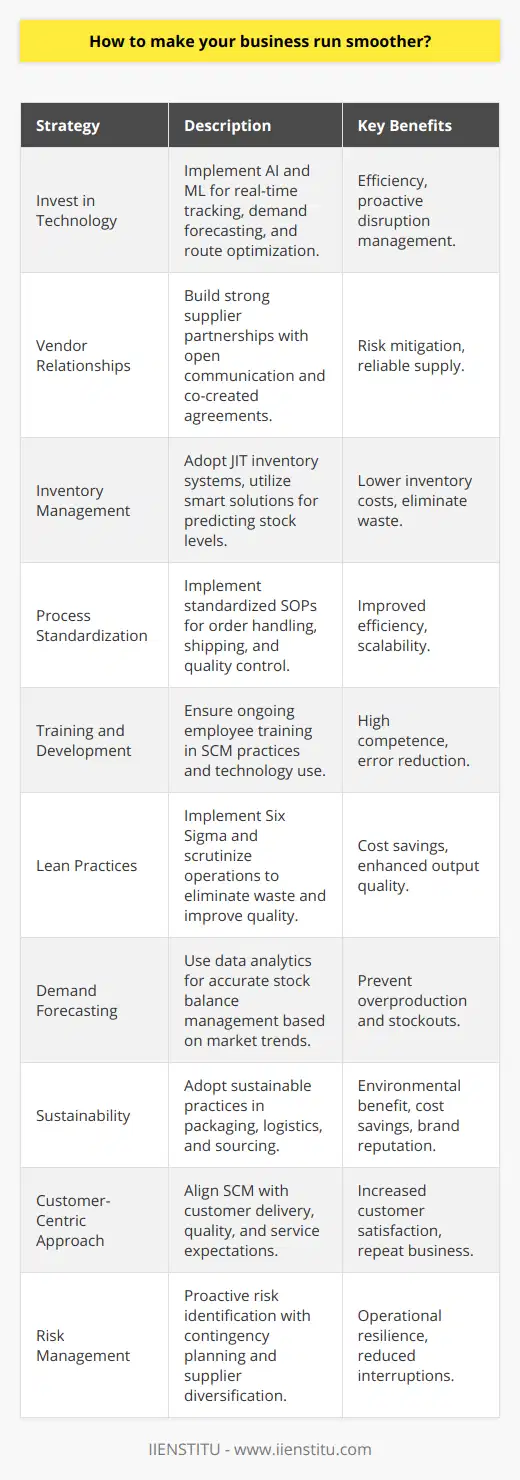
What is the importance of communication with your suppliers?
Communication with your suppliers is important for a few reasons. Communication can help build stronger relationships, allow you to be up-to-date on their latest developments and better anticipate potential problems that might arise in the future.
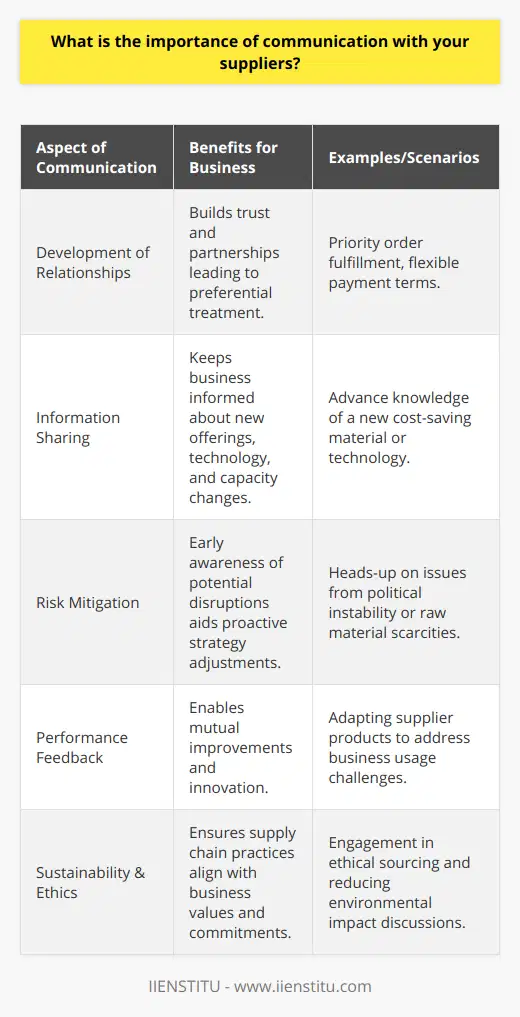
What are the different aspects of supply chain management?
Supply chain management is the process of getting products from raw materials, to manufacturing and finally distribution.

What are the key factors to consider when optimizing supply chain efficiency?
Supply Chain Optimization Factors
Demand Forecasting Accuracy
Accurate demand forecasting plays a critical role in enhancing supply chain efficiency. It informs production planning, inventory management, and procurement decisions, ensuring that organizations consistently maintain sufficient stock levels to meet customer needs while minimizing costs associated with excess inventory and stockouts.
Sourcing and Supplier Management
Selecting the right suppliers and fostering strong relationships with them is vital for an efficient supply chain. Factors such as price, quality, delivery reliability, and the supplier's ethical and sustainable practices should be taken into account. Regular evaluation and negotiation with suppliers can improve performance and mitigate risks associated with potential disruptions or changes in global markets.
Inventory Management Strategies
Effective inventory management is essential in optimizing supply chain efficiency. Organizations must strike a balance between holding adequate inventory levels to meet customer demand without incurring excessive storage costs or risking spoilage, obsolescence, or stockouts. Techniques such as just-in-time (JIT) inventory management can help reduce costs and enhance supply chain responsiveness.
Transportation and Logistics
Efficient transportation and logistics are fundamental to a streamlined supply chain. Companies must evaluate different transportation modes and routes to minimize costs and shipping times while maximizing capacity utilization. Implementing advanced logistics technologies, such as real-time tracking and route optimization software, can further improve performance and visibility.
Information Sharing and Collaboration
Enhancing information sharing across supply chain partners can lead to better decision-making and improved efficiency. By fostering visibility and effective communication, organizations can identify bottlenecks, track inventory levels, and monitor supplier performance, enabling proactive responses to potential disruptions or changes in market conditions.
Technology Integration
Incorporating technologies such as the Internet of Things (IoT), Artificial Intelligence (AI), and blockchain can significantly streamline supply chain processes by automating tasks, improving data accuracy, and enhancing tracking capabilities. Organizations must therefore stay abreast of technological advancements and strategically invest in appropriate solutions.
Continuous Improvement
Finally, to maintain supply chain efficiency, organizations should regularly assess performance, learn from past successes and failures, and adapt strategies to changing market dynamics. A culture of continuous improvement and ongoing optimization can result in sustained competitive advantage and enhanced long-term performance.
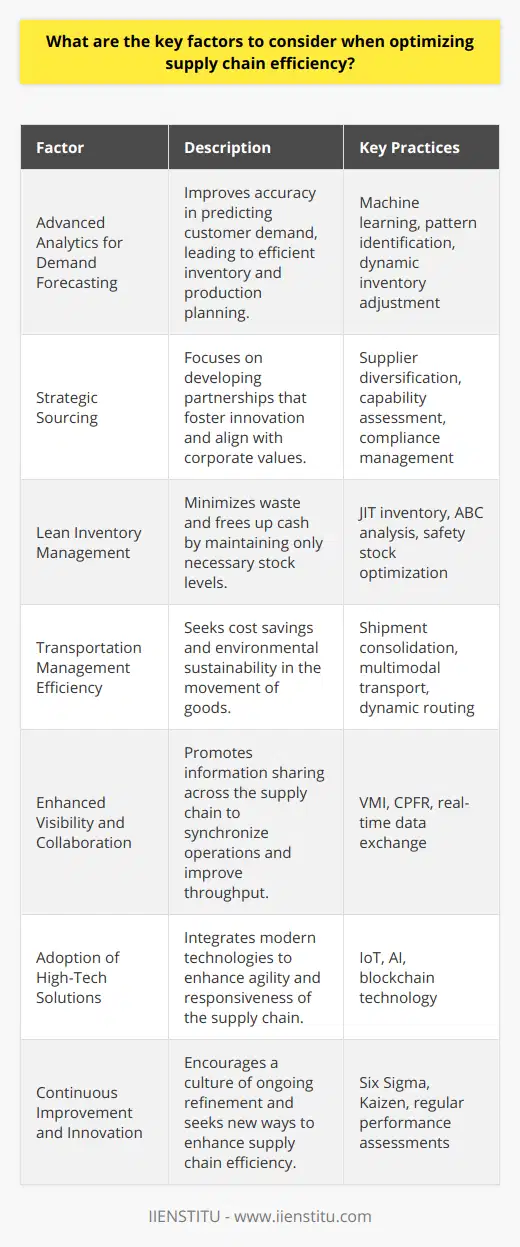
What role does technology play in enhancing supply chain management?
Role of Technology in SCM
Technology plays a critical role in enhancing supply chain management (SCM) by increasing efficiency, reducing costs, and improving communication among supply chain partners. One area where technology has a significant impact is in the automation of processes. By automating routine tasks, technology enables businesses to process large volumes of data quickly, reduce human error, and streamline workflows.
Data Sharing and Analytics
The use of advanced algorithms and data analytics also allows companies to optimize their supply chain operations. They can analyze customer demand patterns, forecasting, inventory planning, and optimize logistics routes. This enables businesses to make informed decisions and improve their responsiveness to market changes.
IoT and RFID Technologies
Technologies such as the Internet of Things (IoT) and radio-frequency identification (RFID) improve real-time data collection and tracking within the supply chain. This enables companies to monitor their inventory levels, understand the status of their assets, and gain insights into their manufacturing processes. This results in better inventory management, improved asset utilization, and reduced wastage.
Blockchain for Enhanced Security
Blockchain technology is emerging as a reliable solution to enhance supply chain security and reduce fraud. By providing an immutable record of transactions, blockchain helps businesses maintain transparency and trust among their supply chain partners. This leads to increased accountability and helps protect companies from counterfeit products and fraudulent activities.
Connection through Cloud-Based Systems
Cloud-based systems facilitate the communication and collaboration of supply chain partners. These systems allow businesses to operate more effectively by sharing and receiving real-time information about developments within the supply chain. This not only improves response times but also helps them adapt to changes more easily.
AI-driven Decision Making
Artificial intelligence (AI) and machine learning (ML) technologies can process enormous amounts of data and provide valuable insights for efficient decision-making. These technologies can also help in predicting trends and identifying potential issues before they escalate. By empowering supply chain managers with accurate predictions and actionable insights, AI-driven decision-making enhances the overall efficiency of supply chain operations.
In conclusion, technology plays an integral role in improving supply chain management by enabling process automation, facilitating data sharing, improving tracking capabilities, and enhancing security. By leveraging technologies like IoT, RFID, blockchain, cloud systems, and AI-driven decision making, businesses can optimize their supply chain processes and stay competitive in the market.
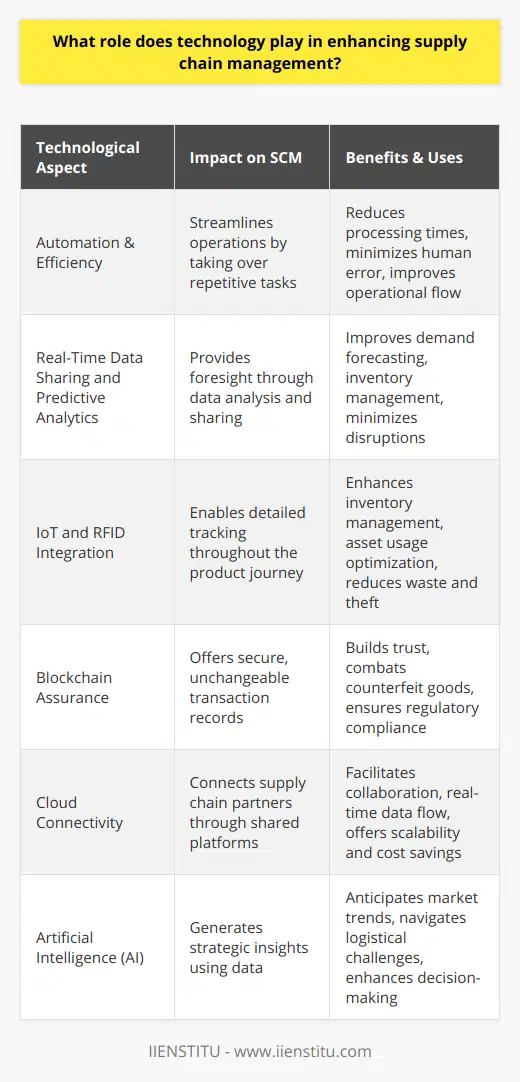
How can an organization align its supply chain strategy with its overall business objectives?
Understanding the Organization's Goals
To align its supply chain strategy with the overall business objectives, an organization must first understand its mission, vision, and overarching goals. These elements are crucial in guiding any decision-making process, including supply chain management. By defining clear, measurable objectives, an organization can assess its current supply chain performance and identify areas for improvement.
Analyzing the Supply Chain Performance
A detailed analysis of the supply chain performance should be carried out, considering factors such as cost, quality, delivery times, and overall supply chain responsiveness. Benchmarking against both internal and external best practices can provide valuable insights into potential improvement opportunities. Conducting a SWOT (Strength, Weaknesses, Opportunities, and Threats) analysis can also inform the organization on the current state of its supply chain and guide necessary changes.
Developing a Comprehensive Strategy
From the results of the analysis, an organization can develop a comprehensive supply chain strategy that aligns with its overall business objectives. The strategy should address aspects such as procurement, logistics, transportation, warehousing, and inventory management. It is important for the strategy to prioritize both short-term and long-term goals, ensuring the supply chain supports the company's growth and development.
Implementing the Supply Chain Strategy
The successful implementation of a supply chain strategy requires the engagement and commitment of various stakeholders, including suppliers, employees, and management. Effective communication, training, and change management processes are vital to ensure that everyone understands the objectives and their role in achieving them. Moreover, setting realistic targets, monitoring progress, and making necessary adjustments in response to changing market conditions or business needs are essential aspects of implementing a successful supply chain strategy.
Monitoring and Adjusting the Strategy
Lastly, an organization should continuously monitor its supply chain performance to ensure that it remains aligned with business objectives. This includes regular reviews of key performance indicators (KPIs), such as lead times, customer service levels, and inventory holding costs. By identifying areas that need improvement or require changes, the organization can maintain a competitive edge and adapt its supply chain strategy to meet evolving business goals.
In conclusion, aligning an organization's supply chain strategy with its overall business objectives involves a thorough understanding of the company's goals, an analysis of the current supply chain performance, the development and implementation of a comprehensive strategy, and ongoing monitoring and adjustments. By doing so, organizations can achieve a supply chain that is effective, efficient, and responsive to their changing needs, ultimately supporting long-term business success.
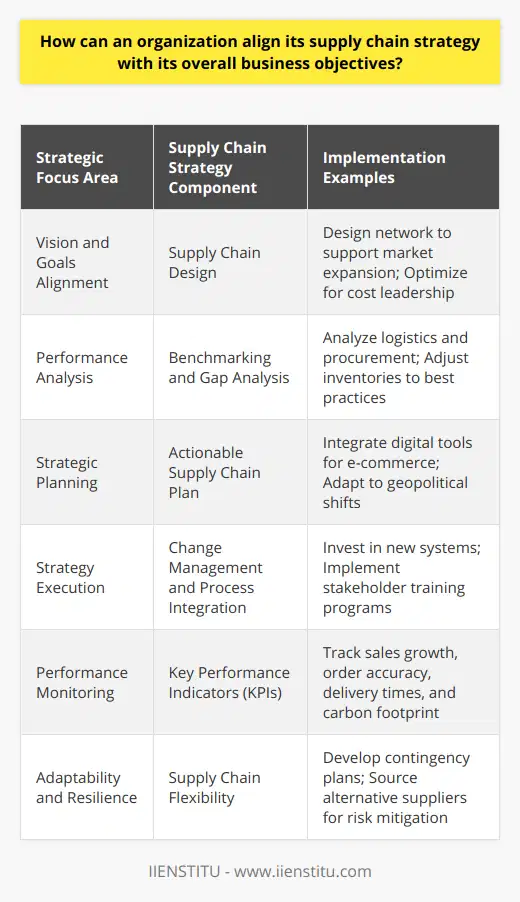
How can you effectively integrate sustainability practices into your supply chain management?
Establishing a Sustainable Supply Chain
To effectively integrate sustainability practices into supply chain management, companies must first assess their current environmental, social, and economic impact. This entails conducting a thorough analysis of their raw material procurement, manufacturing processes, transportation, and distribution networks. By identifying key areas for improvement, businesses can develop comprehensive strategies to reduce their carbon footprint, decrease resource consumption, and ensure fair labor practices.
Setting Measurable Goals
Establishing clear and measurable sustainability goals is crucial to effectively monitoring progress and ensuring long-term success. These goals should be specific, measurable, achievable, relevant, and time-bound (SMART) to enable proper tracking and assessment. Regularly reviewing progress towards these objectives enables companies to make necessary adjustments to their practices and maintain a continuous improvement mindset.
Collaborating with Stakeholders
Collaboration with both internal and external stakeholders is essential to ensure a holistic approach to sustainability. Involving key suppliers, customers, and regulatory bodies in sustainability discussions can lead to the development of innovative solutions and shared values. This collaborative approach promotes transparency and fosters trust among stakeholders, resulting in a more resilient and sustainable supply chain.
Implementing Circular Economy Principles
Promoting a circular economy within a supply chain can significantly contribute to the long-term sustainability of business operations. This involves minimizing waste generation, implementing recycling programs, and maximizing the warranty of assets through refurbishment, remanufacturing or repurposing. By embracing circular economy principles, businesses can reduce their reliance on raw materials, lower operating costs, and enhance their environmental performance.
Monitoring, Reporting, and Communication
Transparent communication and reporting of sustainability performance is essential for credible and effective supply chain management. Companies should develop comprehensive sustainability reports based on established frameworks, such as the Global Reporting Initiative (GRI) or Sustainability Accounting Standards Board (SASB) guidelines. Transparent reporting enables stakeholders to evaluate a company's performance and holds organizations accountable for their commitments and actions.
In conclusion, effectively integrating sustainability practices into supply chain management requires a multifaceted approach that encompasses goal-setting, collaboration, embracing circular economy principles, and transparent reporting. By adopting these measures, companies can maximize their social, environmental, and economic gains, ensuring a more resilient and sustainable future for all stakeholders.

What are the most effective strategies to mitigate risks within a supply chain?
Supply Chain Risk Identification
The most effective strategies to mitigate risks within a supply chain involve identifying potential threats, designing contingency plans, and ensuring the adoption of these plans. First, organizations must engage in a comprehensive risk identification process that considers possible disruptions to their supply chain, such as natural disasters, political instability, and supplier or service provider failure.
Risk Assessment and Prioritization
Next, companies should assess and prioritize identified risks based on their probability of occurrence and potential impact on business operations. This can be achieved through assigning a quantitative value to each risk or by qualitatively comparing pros and cons. Prioritization helps in focusing resources on the most significant threats and ensuring efficient risk management.
Contingency Planning and Implementation
The development of contingency plans for high-priority risks is a crucial step in mitigating supply chain disruptions. These plans should detail alternative suppliers, processes, and technologies that can be utilized in the event of a disruption. Additionally, organizations should establish communication and information-sharing protocols to ensure timely response and recovery.
Supplier Relationship Management
Establishing strong partnerships with suppliers and service providers contributes to effective risk mitigation efforts. By fostering transparent relationships and open communication channels, businesses convey their risk management expectations and better understand their partners' capabilities, weaknesses, and potential areas of improvement. This collaborative approach can lead to risk reduction and resilience within the supply chain.
Risk Monitoring and Review
Continuous risk monitoring and periodic review of risk management strategies ensure the relevance and effectiveness of mitigation actions. Organizations need to regularly update risk assessments and contingency plans to account for changes in the business environment, market dynamics, and emerging trends. Moreover, conducting simulations and drills can help validate and refine risk management strategies.
Overall, a proactive and systematic approach to supply chain risk management, characterized by risk identification, assessment, prioritization, contingency planning, supplier relationship management, and risk monitoring, is essential for minimizing supply chain disruptions and ensuring resilience in the face of uncertainties.
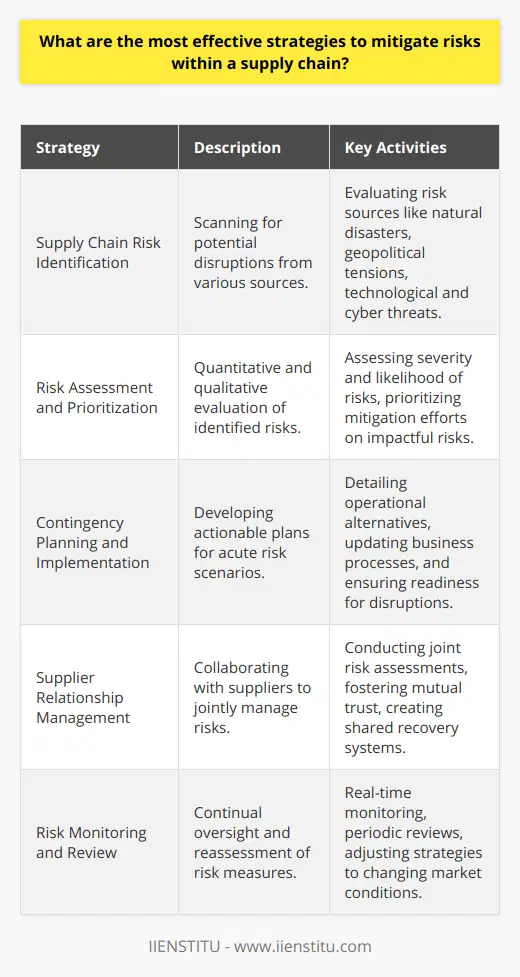
How can collaboration and strategic partnerships enhance the performance of a supply chain?
Enhancing Supply Chain Performance through Collaboration
Collaboration enables supply chain partners to share critical information and resources, facilitating a smooth flow of goods and services. When organizations work together, they can leverage each other's strengths to optimize the entire supply chain process. Strategic alliances can provide access to new markets and reduce costs by sharing risk and resources.
Effective Communication
A key factor for successful collaboration is effective communication between supply chain partners. Sharing real-time information allows for better decision-making and improved responsiveness to changes in demand. Transparency and trust among partners foster an environment conducive to identifying potential disruptions and addressing them promptly.
Resource Sharing
Collaborative supply chain management often involves pooling resources, such as transportation, warehousing, and inventory management. Shared resources not only result in cost savings but also enable partners to access specialized skills, technologies, and infrastructure. By leveraging each other's strengths, companies can improve overall supply chain efficiency and agility.
Risk Management
Strategic partnerships can help mitigate supply chain risks through joint planning, risk-sharing agreements, and continuous monitoring of potential threats. Collaborative efforts to identify vulnerabilities, as well as the development of contingency plans, can minimize disruptions and maintain a supply chain's integrity during changing circumstances.
Innovation and Continuous Improvement
Joint projects and knowledge sharing among supply chain partners can spur innovation in processes, products, and technologies. Access to new ideas and best practices can lead to improvements in operational efficiency and increased competitiveness. Partners can also work together to establish clear performance metrics and identify opportunities for ongoing development.
Expanding Market Reach
Strategic partnerships can increase market reach through shared customers and channels. By pooling their resources, partners can secure better deals with suppliers, customers, and other stakeholders, generating a competitive advantage in the marketplace.
In conclusion, collaboration and strategic partnerships can significantly enhance supply chain performance by improving communication, sharing resources, managing risks, fostering innovation, and expanding market reach. By working together, organizations can optimize processes, reduce costs, and boost their competitive advantage in a globalized environment.

How can an organization develop a comprehensive demand forecasting system to improve supply chain efficiency?
Understanding the Components of Demand Forecasting
To develop a comprehensive demand forecasting system for an organization, the first step is understanding the components of demand. This includes factors such as seasonal variations, promotional activities, and economic changes. Analyzing historical sales data, external trends, and industry benchmarks can provide valuable insights to identify patterns and anticipate future market shifts.
Implementing Forecasting Techniques
There is a range of quantitative and qualitative techniques that can be employed to predict future demand. Quantitative techniques involve analyzing historical data to develop time-series forecasts or using causal methods, such as regression analysis. On the other hand, qualitative techniques rely on expert opinions or market research to make predictions. Organizations should select the most appropriate method by considering factors like data availability, level of accuracy desired, and the time horizon of their forecasts.
Leveraging Technology Solutions
In recent years, technology has become critical for improving demand forecasting accuracy. Organizations can adopt software solutions that facilitate the analysis of large datasets, enable real-time data updates, and automate the forecasting process. Advanced technologies like artificial intelligence and machine learning can further enhance the system by recognizing patterns and trends that may not be easily perceived by humans.
Incorporating Collaborative Approach
A successful demand forecasting system goes beyond the organization's boundaries by involving multiple stakeholders, such as suppliers, distributors, and customers, in the forecasting process. This collaborative approach, known as Collaborative Planning, Forecasting, and Replenishment (CPFR), helps participants share information, jointly evaluate risks, and align their plans, thereby optimizing supply chain performance.
Continuous Improvement Process
Finally, it is crucial to establish a continuous improvement process to refine the demand forecasting system over time. Organizations should regularly evaluate the accuracy of their forecasts, identify areas of improvement, and implement corrective actions. Also, remaining adaptive to market changes or new technologies is essential to maintain an efficient forecasting system in the long run.
In conclusion, organizations can develop a comprehensive demand forecasting system by understanding the factors affecting demand, employing suitable forecasting techniques, leveraging technology, incorporating collaboration, and promoting continuous improvement. This will contribute to a more efficient and agile supply chain able to adapt to market fluctuations and fulfill customer requirements more effectively.
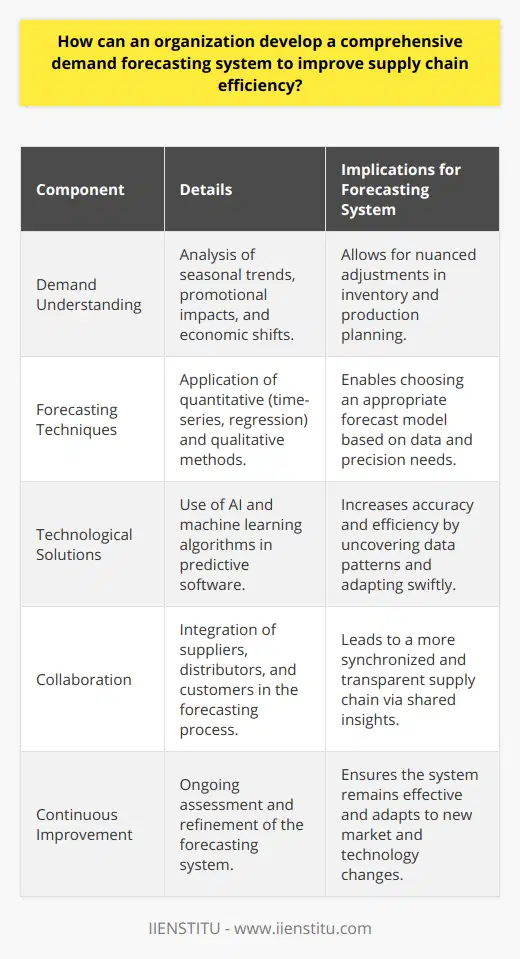
What are the best practices for inventory management to optimize storage costs and ensure product availability in the supply chain?
Optimal Inventory Management Techniques
Implementing effective inventory management practices is crucial for maximizing storage cost savings and ensuring product availability in the supply chain. The following techniques can help optimize inventory management.
ABC Analysis
ABC analysis involves categorizing products based on their value and sales volume. High-value products (A items) require strict monitoring, while low-value products (C items) need less attention. Streamlining resources and management efforts accordingly helps reduce storage costs and prioritize product availability.
Just-in-Time (JIT) Inventory
The JIT inventory method aims to minimize stock holding by purchasing or producing goods only when needed. By adopting this technique, businesses can limit storage costs, minimize waste, and maintain product availability in line with consumer demand.
Safety Stock
Safety stock is the inventory kept as a buffer against unforeseen supply chain disruptions or fluctuations in demand. Maintaining an appropriate safety stock level helps guarantee that products are always available, without inflating storage expenses.
Economic Order Quantity (EOQ)
The EOQ model calculates the optimal order quantity that minimizes the total cost of inventory, consisting of ordering, holding, and shortage costs. Applying the EOQ formula facilitates making informed decisions regarding order volumes, thus optimizing overall inventory expenses and product availability.
Cycle Counting
Cycle counting is a process of regularly auditing a specific portion of inventory, rather than conducting a full physical inventory count. This method helps identify discrepancies quicker, leading to more accurate inventory data, reduced stockouts, and lower storage costs.
Inventory Turnover Ratio
Measuring the inventory turnover ratio is vital to assess the effectiveness of inventory management practices. A higher turnover rate indicates that a business is efficiently moving inventory, resulting in lower holding costs and optimal product accessibility.
Technology Integration
Leveraging technology solutions, such as inventory management software, radio frequency identification (RFID), and barcode scanning, can help streamline and automate inventory control processes. These tools contribute to reduced human error, improved data accuracy, and better-informed decision-making.
In conclusion, implementing optimal inventory management techniques, such as ABC analysis, JIT inventory, safety stock, EOQ, cycle counting, monitoring inventory turnover, and integrating technology, can effectively optimize storage costs and guarantee product availability in the supply chain.
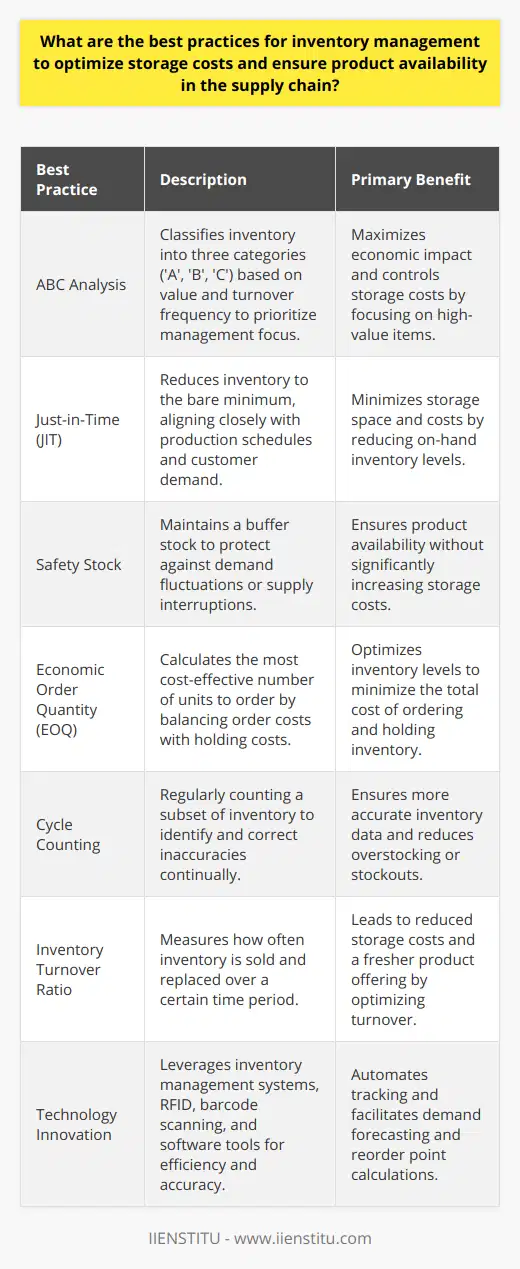
How can an organization identify and address bottlenecks within the supply chain to enhance overall performance?
Identifying Bottlenecks
An organization can identify bottlenecks within the supply chain by conducting a thorough analysis of each stage of the process, determining the capacity and efficiency of every individual component. The first step is to recognize the various steps within the chain and analyze their respective workloads, performance metrics, and throughput.
Using Performance Metrics
Key performance indicators (KPIs) can reveal important insights into the efficiency of each stage in the supply chain. By monitoring KPIs, such as order fulfillment time, inventory turnover rates, and lead times, an organization can pinpoint potential bottlenecks and areas requiring improvement. Analyzing these data-driven insights allows organizations to make better-informed decisions on where to allocate resources and streamline processes.
Applying Process Improvement Tools
Several process improvement tools, such as the Lean manufacturing method, the Theory of Constraints (TOC), and the Six Sigma methodology, can help organizations effectively address identified supply chain bottlenecks. These tools focus on eliminating waste, reducing variation, and optimizing processes, thereby increasing the overall efficiency and performance of the supply chain.
Implementing Technology Solutions
To further enhance the efficiency and performance of the supply chain, organizations can leverage various technology solutions, such as supply chain management software, automation systems, and data analytics tools. These solutions facilitate increased visibility, real-time tracking, and enhanced collaboration between various stakeholders in the supply chain, resulting in improved decision-making and faster response times to potential bottlenecks.
Adopting a Collaborative Approach
Ensuring optimal communication and collaboration among stakeholders, including suppliers, manufacturers, and distributors, is essential for addressing bottlenecks and improving overall supply chain performance. By fostering strong working relationships, organizations can share vital information, align objectives and expectations, and work together to resolve any identified obstacles.
Continuously Monitoring and Adapting
Finally, an organization must continuously monitor its supply chain performance and adapt strategies to ensure ongoing success. By regularly reviewing performance metrics and adjusting processes as needed, organizations can proactively mitigate potential bottlenecks, achieve higher levels of efficiency, and enhance overall supply chain performance. This constant evaluation and adaptation foster a culture of continuous improvement, leading to long-term success in supply chain operations.
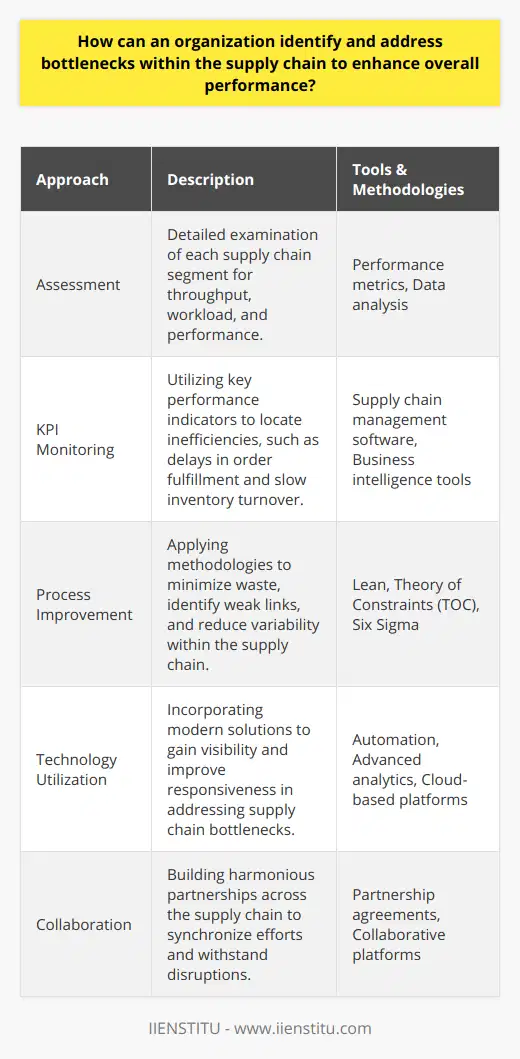
How can a company effectively measure and evaluate the performance of its supply chain?
**Identifying Key Performance Indicators**
To effectively measure and evaluate the performance of its supply chain, a company should begin by identifying key performance indicators (KPIs) relevant to their unique business goals and strategies. KPIs are quantifiable metrics that reflect how well a company, department, or individual is achieving their objectives. By establishing these indicators, a company can create benchmarks for assessing supply chain performance and identifying areas for improvement.
**Data Collection and Analysis**
Once KPIs have been chosen, the company should adopt reliable data collection methods to obtain accurate and timely information on the KPIs. Properly collecting, storing, and analyzing data can be essential in gaining valuable insights, diagnosing problems, and developing strategies for improvement. Employing advanced analytics tools, such as predictive analytics and artificial intelligence, can also help uncover hidden patterns or correlations in the data, which can contribute to better decision-making regarding supply chain management.
**Benchmarking with Industry Standards**
Comparing current performance against industry standards can also be an essential step in evaluating the supply chain efficiency. By benchmarking against competitors or other similar companies, a firm can determine if they are lagging, keeping up, or excelling in their supply chain operations. Moreover, this comparative analysis can help identify best practices or innovative approaches that can be adopted to improve the company's supply chain performance.
**Regular Monitoring and Review**
Continuous monitoring of supply chain performance is crucial to ensure the success of any improvement initiatives. Regular review of the KPIs allows for adjustments in strategies or tactics if performance targets are not met or if new opportunities for improvement are identified. In addition, periodic evaluations can help the company remain agile and responsive to changes in the market or industry, ensuring that the supply chain remains efficient and competitive.
**Collaboration with Suppliers and Partners**
Finally, effective measurement and evaluation of supply chain performance cannot be accomplished in isolation. Collaboration with suppliers, partners, and other stakeholders is vital to sharing information, aligning goals, and working together towards continuous improvement. Establishing open communication channels, setting clear expectations and accountabilities, and building strong relationships can contribute significantly to the successful performance evaluation of the supply chain.
In conclusion, measuring and evaluating the performance of a company's supply chain requires a comprehensive approach that includes the identification of relevant KPIs, effective data collection and analysis, benchmarking against industry standards, regular monitoring and review, and close collaboration with suppliers and partners. By employing these strategies, a company can effectively gauge its supply chain performance and implement improvement initiatives to maintain a competitive edge in the market.
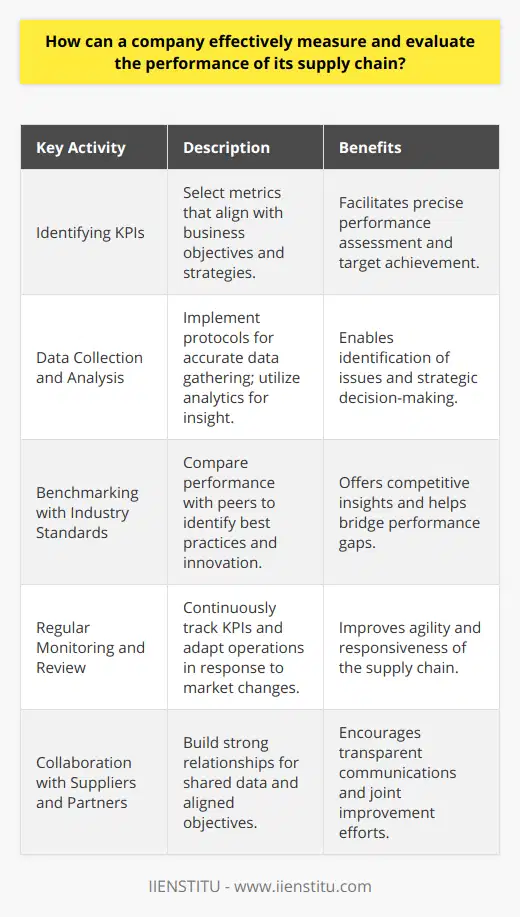
What are the essential elements of a robust and flexible supply chain infrastructure to adapt to changing market conditions?
**Essential Elements of a Robust Supply Chain**
A robust and flexible supply chain infrastructure is crucial to adapt to changing market conditions. Several essential elements contribute to the development of such infrastructure:
**Visibility and Transparency**
Clear visibility into all aspects of the supply chain enables organizations to make informed decisions quickly, mitigating risks associated with disruptions, and identifying opportunities for improvement.
**Responsive and Agile Systems**
Leveraging technology to quickly adapt to changes in demand, suppliers, and logistics mitigates potential failure points, ensuring the continuity of business operations.
**Collaboration and Communication**
Establishing open channels of communication across all stakeholders fosters collaboration, promoting the efficient distribution of resources, problem-solving, and innovation.
**Risk Management and Continuity Planning**
Effective risk management involves identifying potential disruptions, assessing their impact, and developing contingency plans to preemptively address such challenges.
**Diversification and Redundancy**
Ensuring multiple options for sourcing, manufacturing, and distribution minimizes dependencies, while redundancy in key components safeguards against unforeseen events.
**Sustainability and Resilience**
Integrating sustainable practices strengthens a company's resilience, enhancing its ability to recover from disruptions and align with evolving customer preferences.
**Continuous Improvement and Analysis**
Regularly analyzing supply chain performance and implementing improvements ensures the ongoing adaptation and efficiency of processes, resulting in a more robust infrastructure.
Incorporating these elements into a supply chain infrastructure aids in adapting to changing market conditions, ensuring longevity and success for businesses navigating an ever-evolving and complex landscape.

How can data analytics and digital transformation enhance supply chain visibility and decision-making?
Enhancing Supply Chain Visibility
Data analytics and digital transformation have the potential to significantly enhance supply chain visibility by providing real-time information on the status of products and materials at every stage of the supply chain. Through the integration of digital tools, such as sensors, GPS trackers, and Internet of Things (IoT) devices, companies can collect vast amounts of data that can be analyzed and visualized, giving insight into the location, condition, and progress of goods throughout the supply chain.
Improved Decision-Making
Utilizing this data, companies can make more informed decisions, allowing for better planning, forecasting, and resource allocation. Increased visibility enables organizations to monitor and predict potential disruptions in the supply chain, such as delays, equipment failure, or demand fluctuations, which can be addressed preemptively to prevent negative consequences. Through predictive analytics, machine learning, and artificial intelligence (AI), companies can identify patterns and trends in the supply chain data, enabling them to make better strategic decisions and drive operational efficiency.
Collaboration and Integration
Data analytics also promotes collaboration and integration across the various stakeholders in the supply chain, such as suppliers, manufacturers, distributors, and retailers. Through standardized digital platforms and data-sharing tools, partners can easily share information, allowing for a more synchronized, transparent, and agile supply chain. This enhanced collaboration results in improved supplier performance, reduced lead times, and increased customer satisfaction.
Optimizing Inventory Management
Digital transformation and data analytics also facilitate greater inventory control by providing real-time information on stock levels, product demand, and lead times. This enables companies to optimize their inventory management strategies, reducing holding costs and minimizing waste associated with overstocking or product obsolescence. Furthermore, with the help of advanced analytics, organizations can develop intelligent replenishment systems that trigger automated restocking when inventory levels reach predetermined thresholds, ensuring continuous product availability while minimizing stockouts.
In conclusion, data analytics and digital transformation have the potential to revolutionize supply chain management by providing greater visibility, enabling improved decision-making, fostering collaboration, and optimizing inventory management. By leveraging these tools, companies can enhance their operational performance, reduce costs, and gain a competitive advantage in an increasingly complex and dynamic global market.
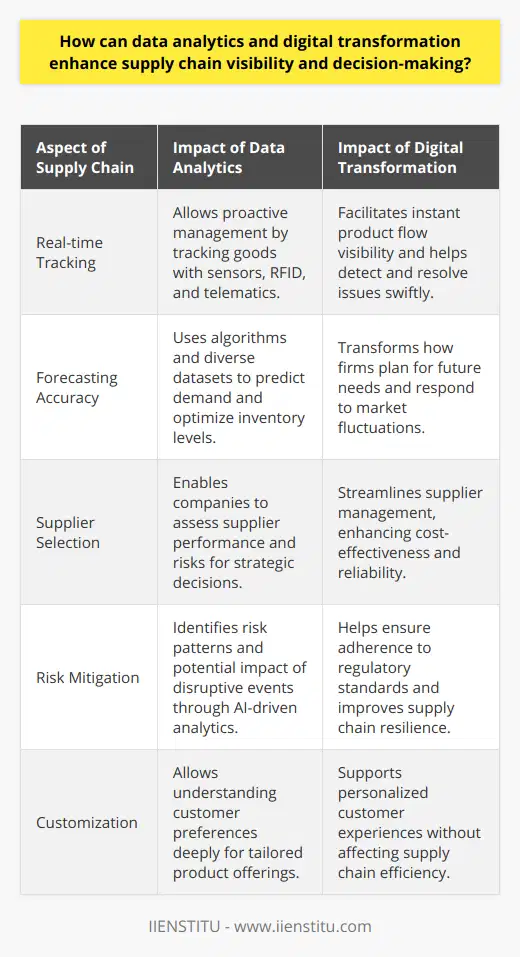
How can you ensure the smooth flow of supply chains in your business?
Effective Communication and Collaboration
To ensure the smooth flow of supply chains in your business, it is crucial to establish effective communication and collaboration between all parties involved. Consistent information sharing allows businesses to anticipate potential disruptions and respond efficiently to changes in demand, minimizing the adverse impact on the supply chain.
Adopting Integrated Technologies
Investing in integrated technologies such as Enterprise Resource Planning (ERP) systems can greatly contribute to the seamless management of your business's supply chains. These systems offer real-time analysis of essential data, allowing you to make informed decisions and boost efficiency by integrating supply chain processes.
Establishing Key Performance Indicators (KPIs)
Another important factor in maintaining smooth supply chain operations is the establishment of relevant Key Performance Indicators (KPIs). Regularly monitoring these metrics allows businesses to identify areas for improvement and address any inefficiencies, ensuring supply chains run as smoothly and effectively as possible.
Building Long-lasting Relationships with Stakeholders
Developing strong and long-lasting relationships with suppliers, distributors, and other stakeholders in the supply chain is crucial for ensuring a smooth flow. These relationships foster trust, reliability, and cooperation, which ultimately contribute to the overall resilience of supply chain operations.
Implementing Risk Management Strategies
To guard against potential disruptions in the supply chain, businesses should implement risk management strategies, including contingency planning and proactive risk mitigation measures. By assessing potential risks and vulnerabilities, companies can reduce the likelihood of disruptions and ensure the continuity of their supply chains.
Maintaining Supply Chain Visibility
Lastly, maintaining visibility throughout the entire supply chain is vital in ensuring its smooth flow. Transparency in every stage of the process helps businesses identify any bottlenecks or challenges as they arise, allowing for swift corrective actions and continuous improvement in performance.
In conclusion, ensuring the smooth flow of supply chains in your business demands a combination of effective communication, technology adoption, performance monitoring, strategic relationship building, risk management, and supply chain visibility. By addressing these factors, businesses can optimize their supply chain operations and maintain a competitive edge in their respective industries.
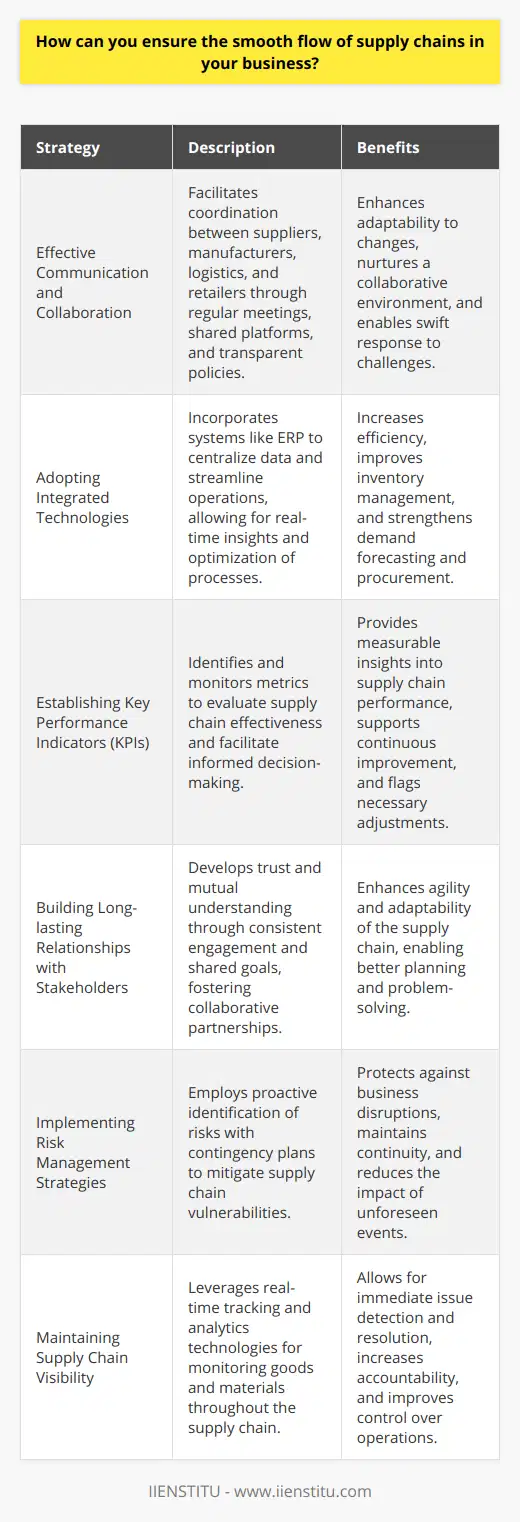
How do you improve supply chain performance?
Supply Chain Performance Enhancement
Strategic Planning and Collaboration
To improve supply chain performance, organizations should focus on strategic planning and collaboration with suppliers, manufacturers, and customers. Aligning strategies and enhancing communication among all parties can foster better working relationships, uncover potential issues before they escalate, and optimize supply chain operations.
Investment in Technology
Digitization and adoption of advanced technologies such as artificial intelligence and machine learning can help facilitate the gathering of critical data for real-time analysis and forecasting. This enables organizations to make data-driven decisions, streamline processes and improve efficiency, ultimately leading to a more robust supply chain.
Inventory Optimization
Efficient inventory management plays a pivotal role in improving supply chain performance. By striking a balance between overstocking and understocking, organizations can avoid unnecessary costs and ensure they are meeting customer demands without delays or stockouts.
Supplier Performance Monitoring
Continuously evaluating and improving supplier performance is instrumental in strengthening supply chain performance. By monitoring and benchmarking supplier delivery rates, quality, and responsiveness, organizations can identify gaps and work with suppliers to address these issues, thus ensuring a reliable and high-performing supply chain.
Demand Forecasting Accuracy
Developing accurate demand forecasts is crucial for efficient supply chain management. By leveraging historical data, market trends and analytics, organizations can create more accurate demand forecasts, minimizing the risk of stockouts or excess inventory while maintaining customer satisfaction.
Agility and Flexibility
In a dynamic market environment, a supply chain must be agile and flexible to adapt to fluctuations in demand, production disruptions, and other unforeseen challenges. Cultivating a culture of adaptability within the organization can encourage continuous improvement and enable organizations to navigate uncertainties effectively.
Transportation and Logistics Management
Lastly, optimizing transportation and logistics can minimize costs, increase delivery reliability, and enhance overall supply chain performance. By implementing a transportation management system, organizations can improve coordination with carriers, reduce transportation costs, and maximize the efficiency of freight movements.
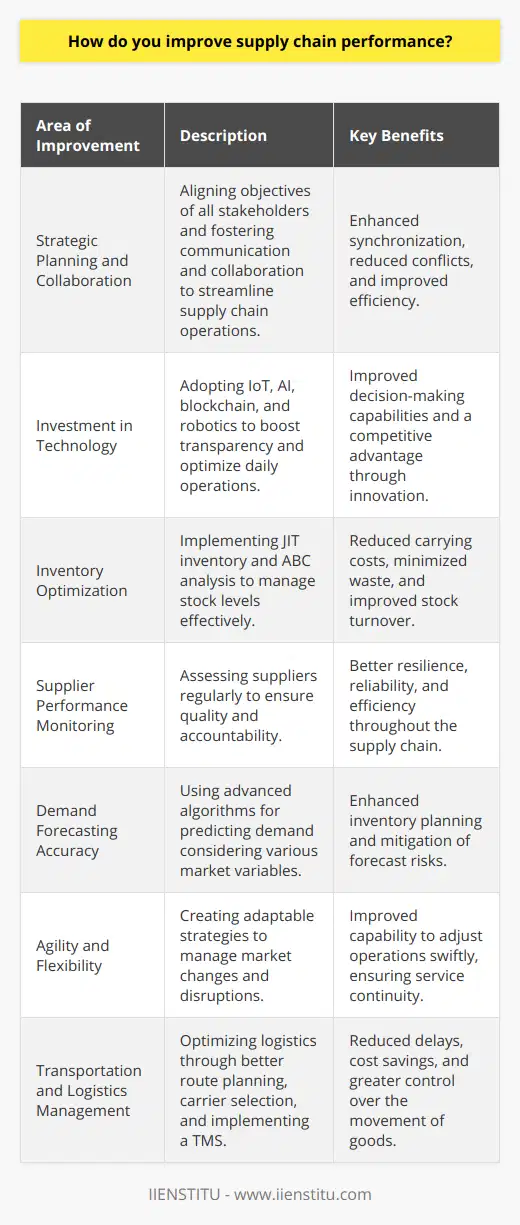
How can a company leverage machine learning and artificial intelligence to optimize supply chain management and planning?
Enhancing Forecasting Accuracy
A company can harness the potential of machine learning (ML) and artificial intelligence (AI) to improve the accuracy of demand forecasting in supply chain management. Through the analysis of historical data patterns and real-time market data, ML algorithms can predict future consumer demands and help companies make informed decisions on managing their inventory. This enables companies to better plan production and allocate resources, thereby reducing uncertainty and extraneous costs throughout the production process.
Facilitating Smart Warehousing
ML and AI-driven technologies also contribute to smart warehousing, streamlining inventory management and optimizing storage space utilization. An intelligent warehouse management system can use AI-generated insights to monitor stock levels, automatically place products in strategic locations, and anticipate peak periods for product demand. Consequently, the warehouse workers benefit from greater efficiency, a reduction in errors, and improved space management, which directly contributes to supply chain optimization.
Optimizing Transportation Decisions
AI-powered solutions can also optimize transportation decisions through route planning, shipment tracking, and anomaly detection. Advanced algorithms utilize available data, such as weather, traffic conditions, and shipment priority, to find the most cost-effective and timely routes for transporting materials and products. Simultaneously, real-time tracking mechanisms enable informed decision-making for any anticipated disruptions, ensuring the swift and efficient navigation of any challenges within the transportation network. Overall, leveraging AI in transportation management results in reduced lead times and optimized costs.
Fostering Collaboration Among Stakeholders
Another essential aspect of supply chain optimization is the fostering of collaboration among stakeholders through AI-driven platforms. These platforms can enable seamless communication among suppliers, manufacturers, and transportation providers. With the incorporation of machine learning algorithms, these collaborative environments can automatically identify potential bottlenecks, suggest contingency plans, and prioritize actions to improve supply chain performance. This leads to enhanced responsiveness, reduced delays, and a more synchronized and efficient supply chain operation.
In conclusion, implementing AI and ML technologies in supply chain management can greatly optimize processes through enhanced forecasting, smart warehousing, dynamic transportation planning, and improved stakeholder collaboration. Consequently, adopting these advanced tools provides a competitive advantage for businesses seeking to navigate the increasingly complex global supply chain landscape.

How can small businesses improve their supply chain in difficult times?
Improving Product Sourcing
Small businesses can enhance the stability of their supply chains by diversifying their sources of supply. During challenging periods, reliance on a single supplier can increase vulnerability. Variety in supply sources reduces the risk of operational disruption.
Exploring Local Supply
One viable strategy is to seek local suppliers. This can significantly reduce transportation time and cost. Moreover, it ensures the quick replacement of inventory in case of unexpected demand increases or supply shortages.
Developing Strong Supplier Relationships
Building strong relationships with suppliers is also essential. Mutual understanding can foster supplier commitment to meeting delivery timelines and maintaining product quality. Regular communication is key to enhancing relationship quality.
Investing in Technology and Automation
Small businesses can improve supply chain operations by leveraging technology. For instance, inventory management software automates tracking, preventing stock-outs and overstocks. Real-time data availability assists in making informed decisions.
Maintaining an Emergency Inventory
Maintaining an emergency inventory can act as a buffer during supply disruptions. Although it may involve additional cost, it provides a safety net against potential shortages.
Adopting Lean Practices
Adopting lean supply chain practices can help in eliminating waste. This can enhance responsiveness and flexibility in difficult times. It requires a systematic review of business processes to identify and eliminate non-value-adding activities.
In conclusion, improving the supply chain in challenging times requires robust strategies that encompass supplier diversification, local sourcing, strong supplier relationships, technology use, emergency inventory, and lean practices. A careful implementation of these strategies can improve supply chain resilience and facilitate business continuity.

How can companies overcome supply chain issues?
Integrated Supply Chain Management
Companies can overcome supply chain issues through integrated supply chain management. This method combines the functions of various supply chain elements into a single, highly efficient system.
Vendor-Managed Inventories
Another solution lies in vendor-managed inventories. In this system, suppliers manage their customers’ inventory levels to reduce stockouts or excess inventory.
Data Analytics
Companies can also leverage big data analytics. Data analysis can identify inefficiencies, forecast demand, and optimize resource allocation. This heightens the overall supply chain performance.
Agility and Adaptability
Agility and adaptability are also paramount. Companies should be able to reroute supplies, find alternative suppliers, and adjust their strategies promptly as circumstances evolve.
Diversification
Having a diversified supply chain can guard against disruptions. Sourcing from multiple suppliers or regions contributes to stability during times of uncertainty.
Sustainability
Lastly, the focus on sustainability should be maintained. Supply chains that consider environmental, economic, and social sustainability will be more resilient in the long run. This is because they cater to changing consumer preferences and regulatory requirements.
In conclusion, overcoming supply chain issues requires both strategic planning and operational flexibility. The integration of these strategies can greatly improve a company's supply chain resilience and efficiency, ensuring smooth operations and business continuity.

How would you improve your company's supply chain management process?
Improving Supply Chain Efficiency
To enhance my company's supply chain management process, I would primarily focus on technology integration. Advanced software systems would facilitate automated inventory management and scheduling.
Optimizing Supplier Relations
Building strong and reliable relationships with suppliers plays a vital role. Regularly evaluating their performance can ensure quality and timely delivery of goods.
Enhancing Information Flow
Efficient communication and information sharing with all stakeholders help minimize confusion and improve coordination. This approach would reduce delays and increase operational efficiency.
Implementing Risk Management Plans
Adopting risk management strategies would prepare the company for potential supply chain interruptions. This approach would entail identifying potential risks and developing contingency plans in case those risks materialize.
Soliciting Employee Input
Furthermore, engaging employees in the process could provide valuable inside knowledge. Employees often possess practical insights that can lead to process improvement.
Regulating Inventory Management
Investing efforts in inventory optimization is crucial. This means maintaining optimal stock levels to meet consumer demands, without overstocking, to improve cost-efficiency.
Promoting Sustainability
Lastly, I would institute sustainable practices in the supply chain management process. Sustainability not only benefits the environment but can also generate positive publicity and goodwill, adding value to the brand.
In conclusion, these strategies aim to provide robust, efficient, and flexible supply chain management. Consequently, they can facilitate smoother operations, lower costs, and increase profitability.
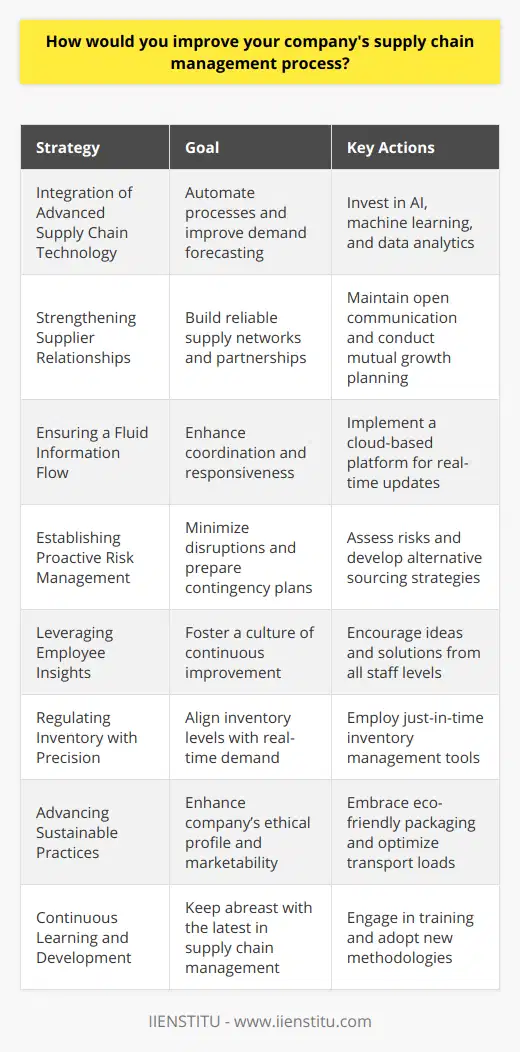
How can small businesses enhance their supply chain resilience during economic downturns or global disruptions?
Supply Chain Diversification
Small businesses can enhance supply chain resilience by diversifying their supplier base. Depending on a single source makes a company vulnerable in case of disruption. Incorporating different suppliers from different regions can mitigate these risks.
Adoption of Technology
Incorporating technology into supply chain management is another strategy. Tools such as Enterprise Resource Planning (ERP) systems can provide real-time data, enabling quicker, informed decisions. This can aid in the discovery of bottlenecks or weak spots in the supply chain before they become problematic.
Stock Optimisation
Stock optimisation can also improve supply chain resilience. Keeping an optimal level of stock, rather than overstocking or understocking, can ensure continuous operations even during disruptions. Inventory management tools can assist with consistent monitoring of stock levels.
Relationship Building with Suppliers
Creating strong relationships with suppliers is key. Open communication channels can enable better understanding of potential risks and prepare businesses to manage them effectively. These relationships also can often provide flexibility and support during times of disruption.
Planning and Preparedness
Lastly, emphasis on planning and preparedness cannot be overstated. Regular risk assessments can identify potential threats to the supply chain. Businesses can then build contingency plans and mechanisms to handle these threats, thus improving overall resilience.
In conclusion, enhancing supply chain resilience requires a multifaceted approach. Small businesses must navigate their unique challenges, using strategies such as diversification, technology integration, stock optimisation, relationship building, and thorough planning. In this way, they can better withstand economic downturns and global disruptions, minimising impact on their operations and ensuring their survival and growth.
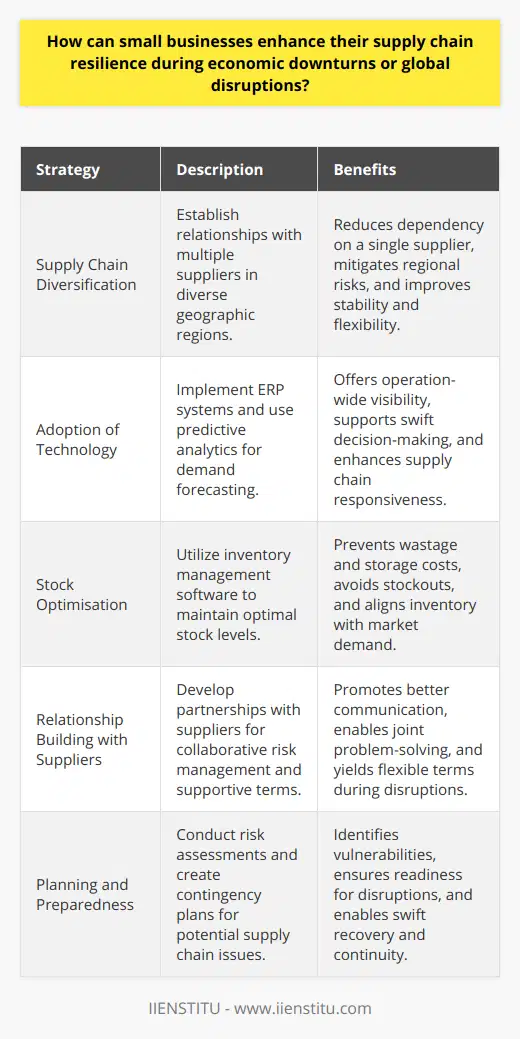
What strategies can be employed to streamline and improve the synchronization of procurement, production, and transportation processes within a supply chain?
Integration of Technology
Firstly, companies can streamline their procurement, production and transportation processes by integrating advanced technology into their systems. This can be achieved through implementation of Enterprise Resource Planning (ERP) and Supply Chain Management (SCM) systems. These digital systems allow for real-time communication and data sharing between different parts of the supply chain, ensuring higher levels of accuracy and efficiency.
Adoption of a Lean Approach
Secondly, organizations can adopt a lean approach aimed at eliminating waste and reducing costs. This includes implementing Just-In-Time (JIT) systems that align procurement and production processes to demand, thus reducing inventory costs and removing unnecessary steps in the supply chain. The lean approach can significantly improve operational effectiveness and profitability.
Collaboration and Partnerships
Collaborating closely with suppliers, manufacturers, and transportation providers is another strategic approach to streamline supply chain processes. Regular communication and active partnerships can ensure everyone understands the common goal, leading to better synchronization of processes.
Sustainability and Transparency
Lastly, achieving sustainability and transparency in supply chain operations should be a core strategy. Utilizing environmentally friendly transport routes and production methods not only benefits the environment, but also fosters customer trust and improves brand image. Businesses should clearly communicate their sustainability initiatives to all stakeholders to ensure compliance and consistency across the supply chain.
In conclusion, by combining these strategies, companies can significantly improve the synchronization of their procurement, production, and transportation processes. This can lead to cost and time savings, improved product quality and increased customer satisfaction. Ultimately, efficient supply chain management is an essential part of business success in today’s competitive market environment.
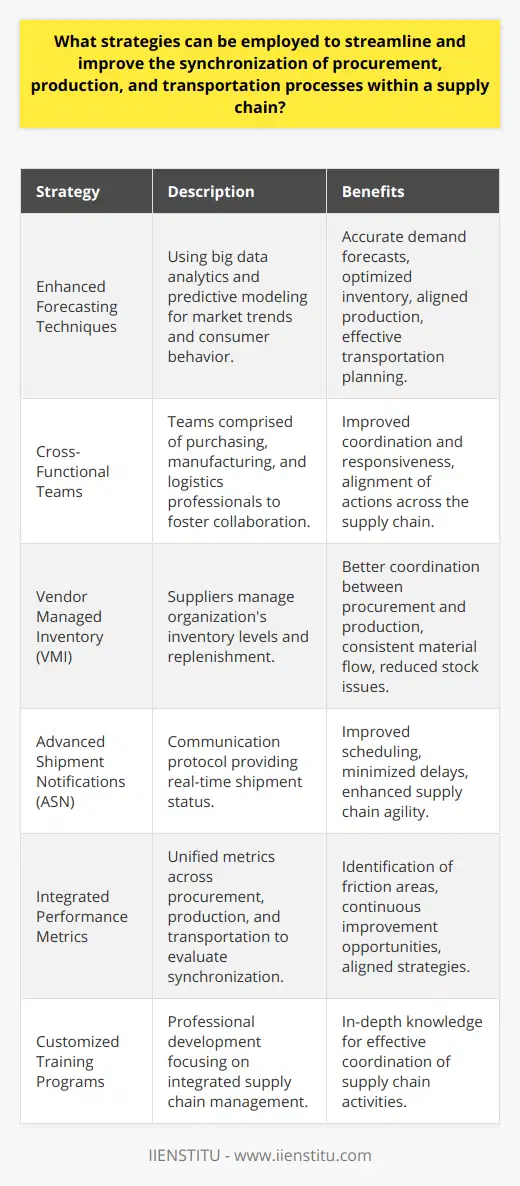
How can organizations ensure ethical and sustainable practices across their supply chain networks to meet growing consumer demands and enhance their brand reputation?
Adopt Transparent Practices
Organizations can optimize ethical and sustainable practices within their supply chains through committing to transparency. Through full supply chain visibility, they are able to supervise all operations. This encourages compliance with ethical standards and laws.
Incorporate Ethical Procurement Policies
Purchasing decisions can affect supply chain ethics significantly. By adopting ethical procurement policies, organizations can ensure that they acquire goods and services from suppliers who meet required ethical standards. This includes fair trade conditions and environmental responsibility.
Implement Robust Monitoring Systems
Regular monitoring and audits can ensure adherence to ethical practices. A robust monitoring system helps track non-compliance issues. Swift corrective actions can then prevent these issues from escalating and hampering brand reputation.
Encourage Supplier Engagement
Engaging suppliers through capacity building programs can help meet ethical and sustainable standards. Such programs can educate them about the organization's commitment to ethical business conduct and sustainability goals.
Promote Sustainability Reporting
Encouraging sustainability reporting shows an organization's commitment to ethical and ecological responsibilities. Additionally, it enhances an organization's reputation among consumers and stakeholders.
In Summary
In conclusion, organizations must embrace transparency, ethical procurement, robust monitoring, supplier engagement, and sustainability reporting to ensure ethical and sustainable practices. These measures help to meet growing consumer demands and enhance brand reputation. This, in turn, fosters customer trust and brand loyalty.
